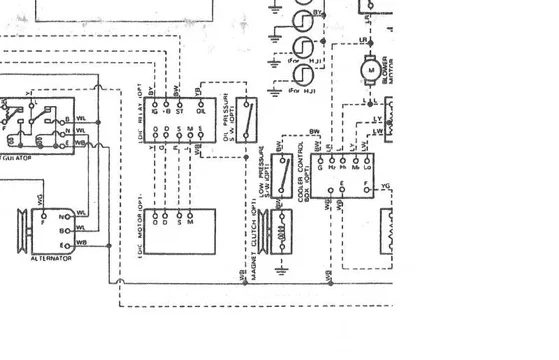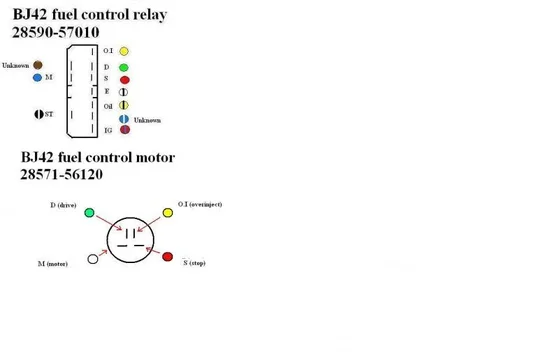I did not get any click at all and my FCR was open so I would have been able to see any movement even if for some reason I could not hear a click. Side note it did click when I accidently touched the Pos(+) to ST

...
The fact that you did not get a click when you earthed the "E" terminal and then (at the same time) applied + 12V to the "IG" terminal ......proves to me that your FCR is really/still faulty Theo. (So I think you are correct to be sourcing another one

.)
..I was not sure if you meant connecting an "additional" Neg(-) or using the existing Neg(-) which was clamped to the E already, so I did both to cover all bases and there was no clicking of any kind......
Jeeez Theo.
And I thought I was being clear in saying "in addition to".

I meant for you to leave the existing "negative/earth" on "E" and apply a fresh one to "Oil" ...... AS WELL.
..Once again I was not sure if you meant using an additional(2nd) Pos(+) or just the existing Pos(+) which was already clamped to IG at that stage, so once again I did both and everytime the Pos(+) touched or broke contact with ST there was an immediate click. ...
Ditto (Again - I meant what I said - "in addition to")
But it sounds like you have at least one relay working there Theo.
Just to be sure I repeated all the tests on my spare 28590-57010 FCR today and got the same results:

(On the front seat of the cruiser.)
..A further side note which may or may not be significant. I have noticed that everytime if I turn the key/ignition to ON when the Glowplug relay(s) click etc , I can hear a definate "schweeet" sound coming from the main glowplug relay. This relay Definately clicks after the glowlight goes off etc but I have not been able to find a bodyground from it at all. I even tried running an earth to its body without any luck. The bolts securing it etc are earthed though. Dunno how significant this is ?? ...
I don't know how significant it is either because I'm unfamiliar with "superglow" (and the timers and starting sequence involved with it) Theo.
Except that I feel your glow operation is likely to be unrelated to your "fuel-control/EDIC operational problem" (especially now we have apparently confirmed a problem with your FCR).
Following this latest testing - I'm pretty confident your existing FCR is indeed faulty. After all, the FCR I'm testing has exactly the same part number as yours (28590-57010) so they should both perform the same under these tests.
Thanks. Nothing really special. It was a nickname from college. People would ask me "Do you think that guy is hot" and I would say "I don't know. I don't care. I guess he's not rat puke or anything like that." So, it stuck. Little did they know that rats can't vomit.
Do You Know Why a Rat Can’t Vomit? | Scienceray
Hey! Thanks for responding Ratpuke. Never thought you'd even stumble across this thread!
Really cool that your username has such a solid history.
I always chuckle too myself when I read "explanations" like that one in your link where someone has gone to a great deal of trouble to make us think their conclusions are "based on science" and "entirely valid". (I once read something similar where someone had the arrogance to claim (with loads of apparent "scientific back-up") that a bumblebee was in fact too heavy to fly!)
If rats are so intelligent about trialing what the eat (by sampling a small bit for ill-effects first) - why do they keep eating (and dying from) my rat poison? (I guess the writer would explain this away by saying that the poison is sophisticatingly
- if there is such a word - deceptive.)
Anyway the term "Ratpuke" conjures up images in my mind of something so vile that even a rat (known to source food from sewers) can't keep it down.
And I like it as a username


PS. In today's tests I timed the "time delay" and it is 8 seconds again (same as in my BJ40 relay) so I've edited this into post #37. (To be truthful - it was 7.5 seconds but what's in half a second?)

 .)
.)





 And Theo - Why do you assume you can fit your FCM with its arm in any random position and that it will automatically put itself in the correct position (stop position) when you connect that connector? Perhaps it should do that ...... but I don't know enough about the operation of the FCR to decide. (I need help
And Theo - Why do you assume you can fit your FCM with its arm in any random position and that it will automatically put itself in the correct position (stop position) when you connect that connector? Perhaps it should do that ...... but I don't know enough about the operation of the FCR to decide. (I need help  )
) ...Not that I really know what a pink flamingo standing on one leg is supposed to mean in smilie language!)
...Not that I really know what a pink flamingo standing on one leg is supposed to mean in smilie language!) (You get a "bounce 2" - and I don't know what that is either.)
(You get a "bounce 2" - and I don't know what that is either.)


